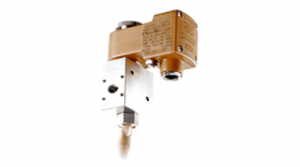

Solenoid valves are used widely in pneumatics as they allow fast responses, automated actuation
and are ideal for fail-safe systems due to their immediate reaction to a cut in the energy source.
A solenoid valve is an electromechanically controlled valve. Its main feature is an electromagnet consisting of a single coil of wire in the shape of a tube. When electricity is passed through the coil it produces a magnetic field at right angles to the current flow. By placing a ferrous metal bar within the coil and applying a current, the electrical energy is converted to mechanical energy; the bar is propelled in linear motion by the resultant magnetic field. Solenoids are used in many applications where automated switching and valves are a feature.
A pneumatic control valve applies the linear motion generated in the solenoid to a piston or actuator within a valve. This allows electronic flow control of liquids or gases. Pneumatic solenoid valves require a constant flow of current to remain open as without the current, the electromagnetic field disperses and the valve returns to its original position. This means that pneumatic control valves are useful in situations where you require automated actuation, fast valve response times or in fail-safe systems.
Solenoid pneumatic flow control valves can be used in any application that requires the flow control of a gas (usually air). Industries that use pneumatic solenoid valves can be from industrial hydraulics, pneumatics to household plumbing and heating. Curious to find out more about solenoid valves? Read our blog post to find out more.
The two-way valve is the most common pneumatic solenoid valve type. A two-way valve has two ports. In terms of operation, pneumatic solenoid valve types are classified by whether they are direct acting valves or pilot-operated (indirect) valves.
Direct-acting pneumatic solenoid valves have a coil which magnetically opens the valve without the need for outside pressure. That is, when electricity is applied to the electric coil surrounding the plunger, the valve is opened (or closed, depending on its resting position). The flow rate and operating pressure directly relate to the diameter of the tube through which the media flows, and therefore direct-operated pneumatic solenoid valves do not require a minimum operating pressure or pressure difference.
Pilot-operated pneumatic solenoid valves, or indirect solenoid valves, have two connected chambers and use a pilot hole in a diaphragm (or cover) to indirectly control the pressure of the media. Once the solenoid valve is energised, the pressure difference controls the lift of the membrane and allows the gas to flow in a single direction. These types of pneumatic control valves are suitable for a high flow rate at high pressures with lower power consumption. A minimum pressure differential is required across the valve to keep them either open or closed.
It is important to select the correct pneumatic solenoid valve for the right application. The type of pneumatic control valve required will depend on the purpose of the system and the media used within it. Fluid Controls has a wide range of pneumatic solenoid valves; we are bound to have one in stock that suits your requirements; please contact us if you need guidance in making your selection.